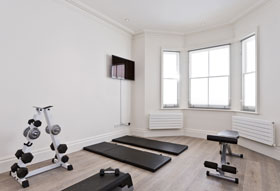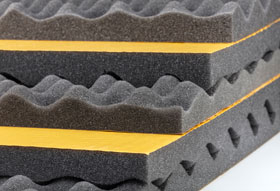How to Soundproof a Home Gym

If you’re lucky enough to have a home gym, fitness shouldn’t be the only thing on your mind. Soundproofing the space is incredibly important to ensure that your activities do not impact others in the home - and most importantly - your neighbours.
What creates noise in a home gym?
There are many sources of noise that come from a gym. The most obvious is music - loud speakers are great for bringing on the gym pump, but aren’t so great for your neighbours or for others in the home. You also have the noise as a result of using treadmills and cross trainers. The thumping sound of running, for example, creates both noise and reverberation, and conveyor belts and the beeps from buttons are also intrusive.
If you work with weights, noise from using them should also be considered. Moving a weight and placing it down on a hard floor can make more noise than you may think, and often transfers noise outside of a room. Likewise, dropping large barbell weights presents an issue. Have you ever been in a commercial gym with an upstairs weight room? Dropped weights cause a huge amount of noise and disruption.
What exactly is soundproofing?
In short, soundproofing is a way to ensure that noise cannot enter or leave a chosen space, such as a home gym. Most soundproofing solutions are made from special foam blocks and/or wall panels which attempt to block the travel of sound waves - ‘attempt’ being the keyword, as not all sound can be completely stopped.

Soundproofing works by absorbing sound waves and soundproofing foam is specially manufactured for this purpose. It works as a barrier, blocking the sound waves from travelling any further. In a gym, it would help ensure that noise from conversations or activities like running would not be heard outside of the room.
Different types of materials for soundproofing
Specialist soundproofing foam is the first choice for soundproofing a home gym. A type of open celled foam, it is designed to absorb sound waves and is available in various different forms. Different types of soundproofing foam also known as Acoustic foam, include flat panels or panels with an egg-crate shaped surface, bass traps, and large soundproof sheets.
In addition to foam, other materials such as mineral, rock or stone wool insulation are good for soundproofing. However, it usually comes at a higher price point and isn’t the most straightforward solution as it requires professional installation.
2 ways to make your home gym soundproof
A soundproof gym should have flat soundproofing foam panels placed on the walls as a minimum. However, those who play loud music in their gym should consider installing soundproofing foam panels on their ceilings too, particularly if the gym is inside the home and not in a separate outbuilding.
Specialist gym flooring and mats also help to soundproof a home gym - hard floors, although easy to clean, are noisy! Interlocking gym tiles or mats are brilliant for this. Likewise, you can also reduce noise from the source by investing in some weight drop mats, which help soften the fall of kettlebells or barbells.
